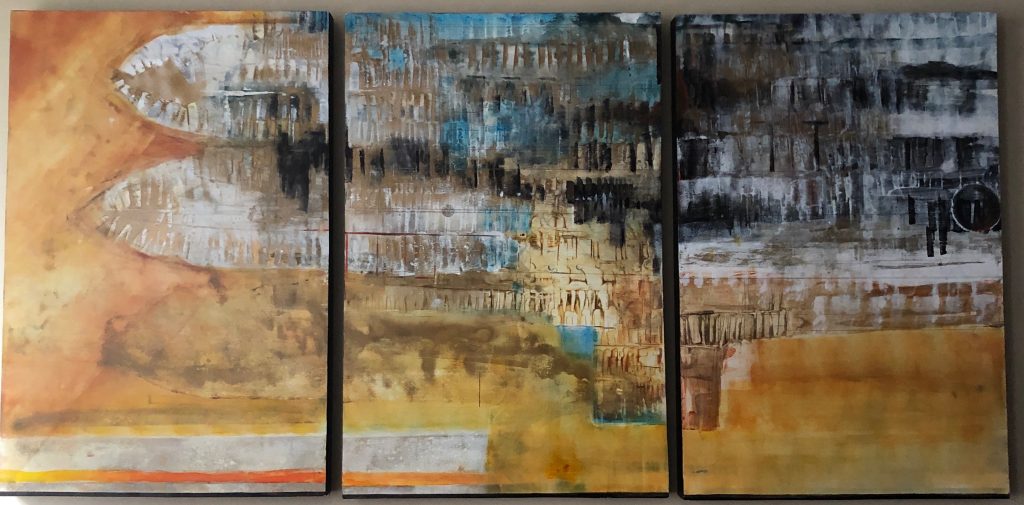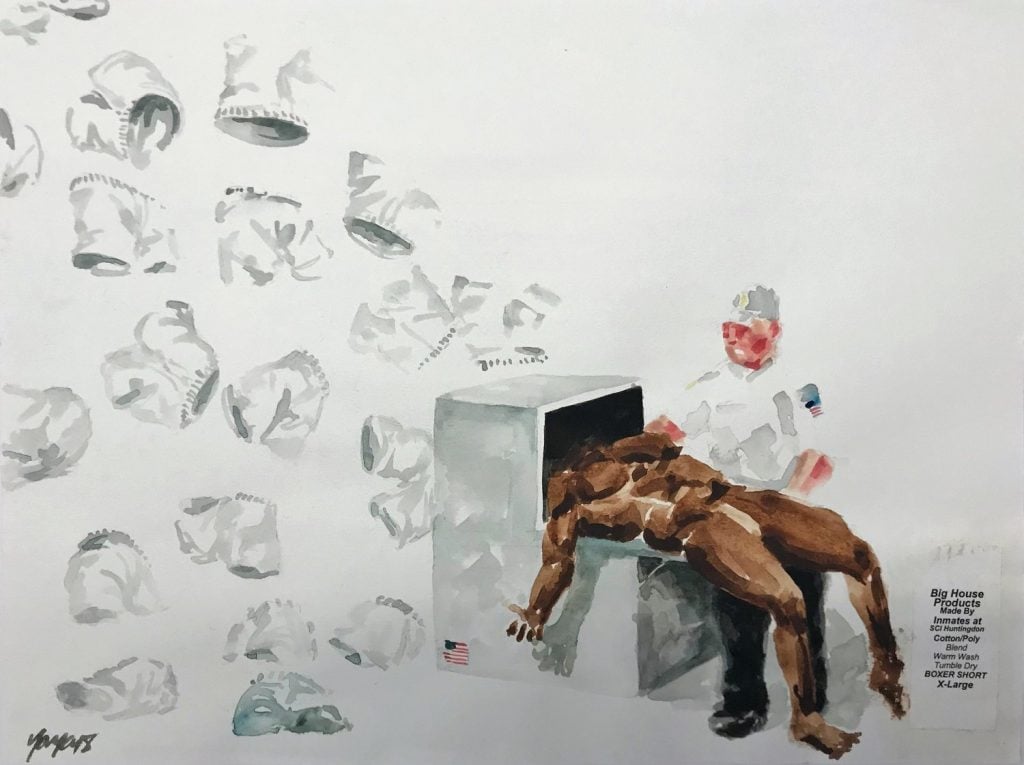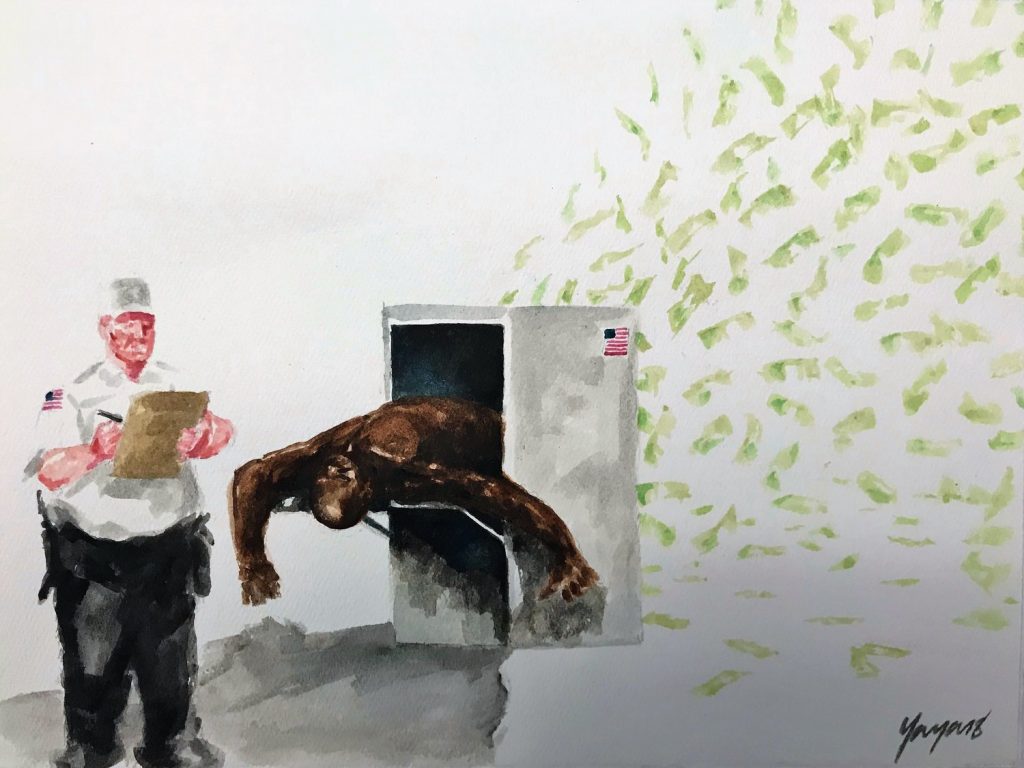In his triptych, Ellapsium: master & Helm (2016), Jared Owens, a formerly incarcerated artist based in New York, superimposes the 1788 diagram of the Brookes slave ship — what art historian Cheryl Finley calls “the slave ship icon” — over the blueprint of Fairton Federal Correctional Institution in New Jersey, where he served time. In this blended image, the slave ship’s hold merges with prison cells, juxtaposing and visually linking the blueprints of the transatlantic slave trade with the architecture of contemporary prisons.
While the image of the slave ship invokes hundreds of years of history, by bringing it into our present, Owens reminds us that slavery did not end with the Thirteenth Amendment — it exists today in prisons where hundreds of thousands of people are forced to work for little or no pay under threat of punishment.

Jared Owens, Ellapsium: master & Helm (2016). Courtesy of the artist.
As an academic and a curator, I have spent decades exploring the visual culture of prisons and mass incarceration through the work of currently and formerly incarcerated artists. To the researcher, archivist, or casual observer, the extent to which slavery permeates prison art is striking. Prison art debunks the myth that slavery was abolished and makes the reality abundantly clear: slavery persists in the U.S. through the forced captivity and labor of incarcerated people.
On Juneteenth, we commemorate the end of slavery in the U.S. Not the actual date the Emancipation Proclamation was issued, on January 1, 1863, but two and a half years later, when federal troops arrived in Galveston, Texas to enforce it on June 19, 1865.
The holiday is therefore a fitting reminder of our country’s contradictions. But those contradictions continue today because the Thirteenth Amendment, which most believe abolished slavery, includes an exception that allows for slavery as punishment for a crime.
That’s the political backdrop for the role that slavery plays today in prison art — it’s the reality of the incarcerated artist. The forced labor extracted from incarcerated bodies should cause alarm, but instead most of American society seems not to care that slavery is embedded into the criminal legal system.
The normalization of forced labor practices in prison, and the various entities that profit from incarceration, are scrutinized in James “Yaya” Hough’s watercolor paintings, How Big House Products Make Boxer Shorts (2018) and I am the Economy (2018). The works were winning entries in an art competition for incarcerated artists hosted by the New York-based non-profit Worth Rises.

James “Yaya” Hough, How Big House Products Make Boxer Shorts (2018). Courtesy of the artist.
In both paintings, Hough shows the image of an unclothed Black man being fed into a machine by a white correctional officer in uniform. In How Big House Products Make Boxer Shorts, the man-fed machine produces underwear with an affixed label that reads: “Big House Products. Made by Inmates.” Despite being manufactured by people earning pennies an hour, the garments are then sold back to the incarcerated population at exploitative prices. In I am the Economy, the machine simply produces dollar bills, a more general criticism of the brutally extractive prison industry.
While Owens’ Ellapsium captures the architectural continuity of slavery—the warehousing of Black bodies—Hough’s paintings offer a shocking and minimalist depiction of modern day slavery. Prison art forces us to confront the persistence of enslavement enshrined in the Thirteenth Amendment, not merely as an abstract legal concept, but as a reality today.
This Juneteenth, formerly incarcerated artists are working with organizations like the Philadelphia Mural Arts Project to help end the exception in the Thirteenth Amendment. They’re using art to organize around the Abolition Amendment, a federal bill that would truly abolish slavery for all. It’s time we address the reality conveyed in prison art: slavery is still very real.
Nicole Fleetwood is an author, curator, and professor at New York University.











